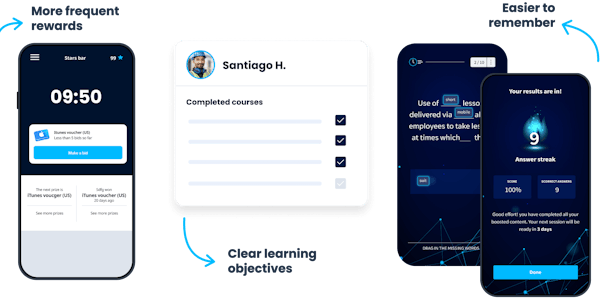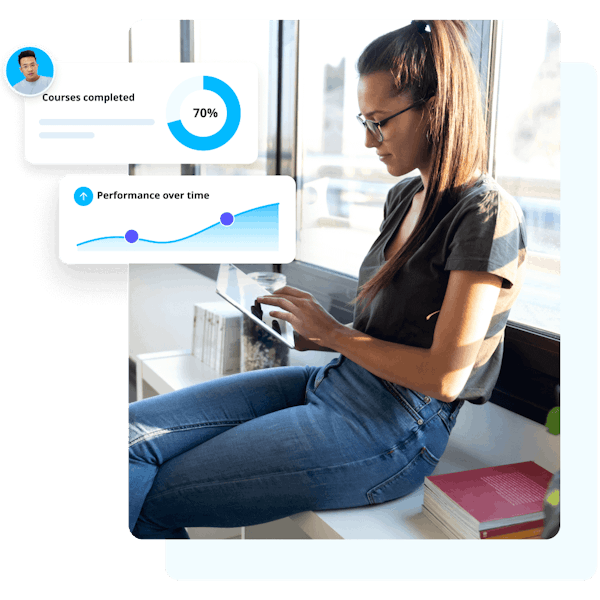10 Key benefits of microlearning for corporate L&D

Rapid technological advancements and evolving work landscapes are redefining traditional approaches to learning to meet the needs of today's dynamic workforce. Here enters microlearning, a transformative training strategy that delivers bite-sized bursts of knowledge.
This innovative approach recognizes time constraints and the demands of busy schedules, offering learners a more flexible, engaging, and efficient means of acquiring skills. In this article, we’ll explore various benefits of microlearning such as enhanced retention and adaptability.
In this learning and development landscape, small yet impactful learning experiences are shaping the future of professional training and fostering a culture of continuous learning.
What is microlearning?
Microlearning is a learning strategy that delivers small, focused bursts of content to learners, typically in the form of short modules or lessons. This approach is characterized by its brevity and specificity, aiming to convey targeted information in a concise manner.
This approach recognizes the constraints of modern learners' attention spans and busy schedules, presenting content in easily digestible formats that can be quickly consumed.
It uses multimedia elements, interactive features, and gamification to enhance engagement and retention.
The key objective of microlearning is to give learners immediate, relevant knowledge or skills that can be applied in real-world situations, fostering a culture of continuous learning and adaptability.
Now, let’s learn more about the specific benefits of microlearning.
Benefit of microlearning #1: Continuous Learning Culture
Microlearning fosters a continuous learning culture by offering regular, bite-sized learning opportunities that seamlessly integrate into daily routines. This encourages employees to engage in ongoing skill development, promoting a mindset of continuous improvement.

With easily accessible and digestible content, learners can stay abreast of industry trends, adapt to evolving job requirements, and enhance their expertise over time. The flexibility of microlearning allows them to take control of their professional development.
This approach contributes to a workplace culture that values and supports continuous learning as an integral part of personal and organizational growth.
EdApp is your gateway to creating a vibrant continuous learning culture within your organization. As a cutting-edge microlearning tool, EdApp excels in delivering engaging and easily digestible content that seamlessly integrates into the busy schedules of modern learners.

With its user-friendly interface and adaptive design, EdApp empowers employees to access personalized learning paths. This allows them to choose modules aligned with their individual goals and job requirements.
The platform's real-time tracking and analytics allow your organization to measure progress effectively, making sure that learning targets are achieved.

Plus, EdApp's ability to swiftly update any content showcases its commitment to adaptability, keeping your workforce updated with the latest industry trends and benefits of microlearning.
Sign up to EdApp for free to drive continuous improvement and success in your organization.
Benefit of microlearning #2: Time Efficiency
Microlearning offers focused training content that can be consumed in short amounts of time. By breaking down complex topics into manageable modules, microlearning allows learners to acquire targeted knowledge or skills without lengthy time commitments.

This approach maximizes productivity as it seamlessly integrates learning into daily routines, making it particularly suitable for professionals juggling multiple responsibilities.
Among the benefits of microlearning, time efficiency also enhances learners’ retention rate by making sure that they can quickly grasp and apply any information they’ve learned.
Benefit of microlearning #3: Accessibility
As a champion of accessibility, microlearning offers the flexibility to access modules anytime, anywhere, and on various devices. Like other benefits of microlearning, this accommodates diverse learning styles and preferences.

Its accessibility not only caters to the demands of modern, on-the-go lifestyles but also expands learning opportunities to a broader audience.
Remote workers, part-time employees, and individuals with limited time for traditional training all benefit from the convenience of microlearning. It successfully breaks down geographical and temporal barriers.
By embracing the accessibility of microlearning, your organization can make sure that learning is inclusive. It can reach a wide spectrum of learners and facilitate continuous skill development regardless of their location or time constraints.
Benefit of microlearning #4: Cost-Effectiveness
Microlearning emerges as a cost-effective learning solution by streamlining the development and delivery of learning content. Its modular nature allows for the creation of concise, targeted materials that are both impactful and economical.

With reduced development time and resources required, your organization can efficiently address learning objectives without extensive costs associated with traditional training methods.
Plus, the accessibility of microlearning lets employees engage in learning without significant disruptions to their work schedules, minimizing downtime.
This approach guarantees that you can offer effective training even with budget constraints, making microlearning a financially wise strategy for continuous employee development. All of these make cost-effectiveness one of the biggest advantages of microlearning.
Benefit of microlearning #5: Easy Integration
With the available technology today, you can seamlessly integrate microlearning into business. Microlearning fits into existing learning management systems (LMS) or corporate training programs without significant disruptions.

Whether used as standalone modules or complementary components to broader training initiatives, microlearning aligns effortlessly with various learning platforms. This ease of integration allows you to adapt quickly to evolving educational needs.
Microlearning’s adaptability also contributes to a more agile and responsive approach to employee development, enhancing the overall effectiveness of training initiatives.
Benefit of microlearning #6: Engagement
Microlearning training courses increase engagement by taking advantage of their concise and targeted content delivery. By incorporating multimedia elements, interactive features, and gamification, microlearning transforms the learning experience into an engaging and dynamic process.

The bite-sized modules capture learners' attention more effectively, preventing information overload and maintaining interest. This approach accommodates shorter attention spans and encourages active participation and knowledge retention.
By making learning more enjoyable and interactive, microlearning succeeds in keeping learners engaged so they remain motivated enough to consistently participate in the learning process. This way, they can derive maximum value from the learning content.
Benefit of microlearning #7: Reduced Cognitive Overload
As an antidote to cognitive overload, microlearning stands out by offering a streamlined and focused approach to acquiring information.

By breaking down complex topics into bite-sized modules, microlearning prevents the overwhelming cognitive burden that usually accompanies traditional, lengthy training sessions.
This approach allows learners to absorb and process information more efficiently, promoting better understanding and retention.
Its conciseness guarantees that learners can concentrate on specific concepts without feeling overwhelmed, leading to a more effective learning experience.
This reduction in cognitive load enhances the overall learning outcome and contributes to a positive and stress-free educational environment. It fosters a more conducive atmosphere for knowledge absorption and application.
Benefit of microlearning #8: Improved Retention
By strategically delivering information in focused segments, microlearning becomes a potent tool for enhancing retention. The approach capitalizes on the spacing effect, reinforcing learning through repeated exposure to key concepts over time.

With digestible modules, microlearning allows learners to concentrate on specific, easily digestible pieces of information, promoting a deeper understanding.
The short and targeted nature of these modules is designed to align with the way the human brain processes and retains information, maximizing the potential for long-term memory storage.
This results in improved retention rates, as learners are more likely to remember and apply the knowledge gained through these compact, well-structured learning experiences. All of these prove that microlearning is memorable learning.
Benefit of microlearning #9: Adaptability
Microlearning emerges as a highly adaptable learning solution by offering personalized and flexible learning paths that cater to individual needs and preferences.

Learners benefit from the autonomy to choose modules aligning with their specific goals or job requirements, fostering a tailored educational experience.
The adaptability of microlearning is also evident in its ability to swiftly update and modify content. This guarantees its relevance in the face of changing technology, industry trends, or organizational demands.
This dynamic quality not only allows for real-time adjustments but also positions microlearning as a responsive tool that can evolve in tandem with the dynamic nature of modern work. This allows for continuous alignment with learners' needs and the broader context of their roles.
Benefit of microlearning #10: Real-time Application
Real-time application empowers learners to promptly apply newly acquired knowledge or skills in their day-to-day activities. By presenting information in focused, digestible lessons, microlearning eases a quick transition from learning to practical application.

Learners can readily implement what they've learned, reinforcing their understanding through immediate hands-on experience. This aspect enhances the effectiveness of the learning process and makes sure that the knowledge gained is directly relevant to their work.
The real-time application capability of microlearning also accelerates skill development and contributes to a more seamless integration of learning into the workflow. This promotes a culture of continuous improvement and immediate relevance in the professional environment.
What are the objectives of microlearning?
Microlearning aims to accommodate busy schedules while promoting deeper understanding. It reinforces learning through practical application and offers a personalized and engaging learning experience that aligns with specific roles or interests.
These are done by breaking down complex topics into focused segments and delivering information within a short timeframe to respect learners' time constraints.
This approach also enhances retention through spaced exposure to key concepts, encourages immediate application of knowledge or skills in real-world scenarios, and offers adaptive learning paths to cater to individual needs and preferences.
Author
Donna Dane
Donna is an elearning content writer for EdApp, a mobile-based microlearning platform designed for today's digital training needs. When she's not writing web articles, she writes lines of code or songs or anything food-related.
